
Film Editor Alice Weltermann looks back on Gilmore Girls from its cosy and idealised American small-town atmosphere, to the underlying paradoxes of its postfeminist perspective
As the trees turn orange and the heating remains turned off until November it is a natural reaction to huddle around the television for warmth: the cosy Autumn hues and steaming coffee cups of Gilmore Girls (2000-2007) never fails to coax some toastiness into even the coldest of living rooms. Amy Sherman-Palladino’s famously rewatchable series stars mother-daughter duo Lorelai (Lauren Graham) and Lorelai ‘Rory’ Gilmore (Alexis Bledel) as they navigate school/college, work, and their romantic relationships. Set in the fictional town of Stars Hollow, the Gilmores’ lives are filled with wacky small-town characters such as the flirtatious, gossiping dance teacher Miss Patty (Liz Torres), ineffable and awkward Kirk (Sean Gunn) and perpetually grumpy cafe owner Luke (Scott Patterson). Despite there being only two eponymous girls, the town makes up one large silly family around them.
“Gilmore Girls posits small-town life as a kind of American Dream
Gilmore Girls posits small-town life as a kind of American Dream; there is a ready and waiting family on the girls’ doorstep, money a-plenty and the safe familiarity of small-town life whilst still being close enough to New York to see The Bangles there. Following the consumerism and ‘New Money’ of the 1980s and 90s, where an urban city lifestyle was idealised, Palladino puts forward the interesting fantasy world of Stars Hollow and its inhabitants as a dream that occupies a strange postfeminist space
“Their lives, like the expectations of Postfeminism, are filled with paradox
‘Postfeminism’ is widely agreed to be the idea that gender equality has now largely been achieved, allowing for a rejection of feminism and a turn to questions of how the modern women should adequately slot into consumer culture. It upholds the girl as the perfected version of the woman- the ideal consumer. Considering that Gilmore Girls by its very title is defined by girlhood, it is interesting to consider Rory and Lorelai in a postfeminist context. Their lives, like the expectations of Postfeminism, are filled with paradox; Lorelai is a single mother working a normal job but can afford never to cook, surviving on takeaways. At least twice an episode Lorelai and Rory eat junk food, but they stay fit and never gain weight, making fatphobic comments and at the same time poking fun at people who eat salad.
“they achieve an unachievable ideal of femininity and class that molds to the patriarchy whilst still allowing an indulgence
They know an impossible amount of pop culture references and speak mostly gibberish to the enamoured people around them; they have an understanding both of high and low-brow pop culture but draw the line at the overly popular, rejecting bands like Linkin Park or Fleetwood Mac but embracing AC/DC and Metallica. They treat their friends and boyfriends poorly and expect unconditional love in return; they see themselves as self-made and middle-class whilst Lorelai’s parents are inextricably wealthy. In short, they achieve an unachievable ideal of femininity and class that molds to the patriarchy whilst still allowing an indulgence in things like shopping and wearing makeup: Postfeminism.
This is not to say that I don’t like or enjoy Gilmore Girls. There is a reason for the show’s enduring relevance, even 20 years after its release- its infeasibility is what makes it so loveable. What Gilmore Girls chooses to embrace or reject is seemingly arbitrary, decided by whichever quality appeals to most members of the public.
“its infeasibility is what makes it so loveable
The paradoxes of Gilmore Girls demonstrates that nobody can fulfill every social expectation, not even in the fantasy bubble of Stars Hollow, never mind in real life. But Gilmore Girls offers a world in which the unabashed quirkiness of its leads is welcomed, and their paradoxes are never pointed out- they are allowed to be contradictory. In some ways, this makes them more real. Although parts of the show will never make sense, what does is the desire to return to it: a fantasy world that is designed to be comforting, comforts nevertheless.
Read more TV articles here:
Review: Strictly Come Dancing 2023
Comments